
The Prairies and Great Plains once formed the heart of North America. Tall grasses. trees, shrubs and other plant life were destroyed for farming on a scale never before seen.
Millions of acres of habitat and wildlife were wiped out along with wildlife. Still, small pockets of native habit still exist. Little parks and preserves. Some parcels were deemed unworkable, while some people had the foresight to know the importance of native species.
While Switch grass, Indian grass and others get the headlines, native vines play an important roll for your wildlife habitats and prairie gardens as well. No Prairie Garden is complete unless you have at least one native vining plant from your region. Rambling, climbing, clinging clumps of plant life that form thick patches for a slew of wildlife species.
Plants that offer food in the way of nectar for pollinators. Fruits, berries, and seeds provide food for birds and just about every furry creature that roams the vast lands.
Brambles provide places to nest and offer protection from predators. Whether you have a small prairie garden or a large expanse of habitat, your work isn’t finished until you have at least one native vine growing in your Prairie or Great basin Gardens.
Whether you have a small prairie garden or a large expanse of habitat, your work isn’t finished until you have at least one native vine growing in your Prairie or Great basin Gardens. Even Poison Ivy offers food and protection.
Weather conditions can drastically vary from season to season, not to mention with locations so picking the right native vines may be a challenge for you. With the help of this page, I have found some of the most desirable vines for your Prairie gardens and habitats. While some aren’t for the small garden, others will do well for you.
I have written down hardiness zones for these plants as a guideline and you may want to check other regions for options. There aren’t as many native vines for the Prairies and Great Plains as there are for the East and southeast, but you do have several of natives to look into, just remember to look at hardiness zones first.
Apois tuberosa or americana
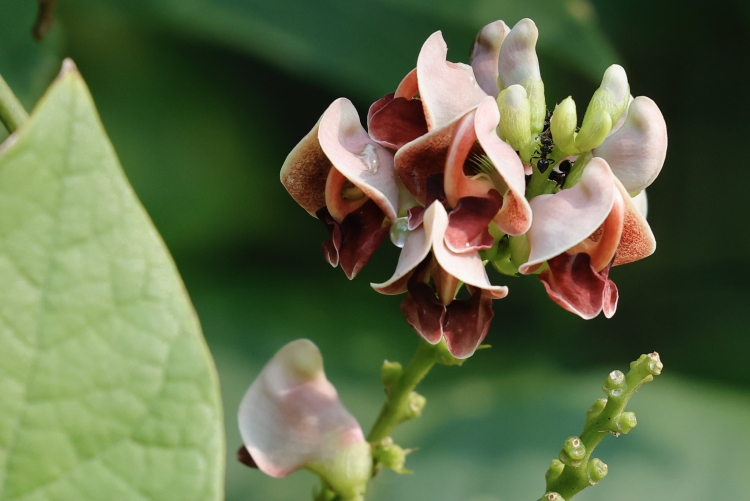
The Ground Nut is a native vining plant to the United States and it’s remnants have been found in archaeological digs of Native American campsites in southern New England that go back 9,000 years.
Tubers or ground nuts are edible.
This plant is a climbing vine that develops pinkish-lavender and maroon flowers which form in clusters that are attractive to hummingbirds and butterflies. Flowers are fragrant and attract other pollinators as well.
This plant may be considered a protected species; check before digging or gathering seeds. Suitable for growing in containers.
- Common Name: Ground Nut
- Zone: 3 to 9
- Plant Type: Vining
- Native Range: Eastern 2/3 of the United States and Ontario and Quebec, Canada
- Height: 15 to 20 feet
- Spread: 4 to 6 feet
- Bloom Time: Late Spring/Early Summer Mid Summer
- Bloom Color: lavender/Maroon in rare occasions purple.
- Sun: Sun to Partial Shade Light Shade
- Water: Medium
- Maintenance: Medium
Aristolochia tomentosa

Dutchman’s pipe vine, a native that is growing in popularity.
Showy flowers attract butterflies. Host plant to Pipevine Swallowtail Butterfly. Expansion of this plant has expanded the range of this beautiful butterfly as well.
Easily grown in average, medium, well-drained soil in full sun to part shade. Prefers rich, moist soils. Intolerant of dry soils. If needed, cut back in late winter to control growth. Grows well from seed.
This species of Dutchman’s pipe is a woody, deciduous, and twining that typically occurs along streams and in moist woods. It is typically seen in the wild climbing trees or shrubs and can rapidly grow to 20-30′ tall. Features large, heart-shaped, densely-overlapping leaves (4-8″ long) which can quickly cover an arbor or trellis with deep green foliage.
Commonly called Dutchman’s pipe because the unusual, 2″ long, yellowish-green, curved-trumpet flowers (each flaring at the calyx mouth to form three brownish-purple lobes) superficially resemble Dutch smoking pipes. Although the flowers make interesting conversation pieces, they are usually hidden by the dense foliage and are somewhat inconspicuous.
Flowers give way to ribbed, tubular seed capsules (to 3″ long) which mature to a grayish-brown in September.
The leaves, young stems and flowers of this native are hairy (tomentose as the species name suggests). Very similar to A. macrophylla which is native to eastern North America, except A. macrophylla is basically glabrous (smooth). Aristolochia is a larval plant for the Pipevine swallowtail butterfly.
No serious insect or disease problems.
Can provide dense cover for sun porches, verandas, pillars, posts, trellises, arbors, fences or walls. Has been popularly used for many years to screen front porches. good selection for a butterfly garden.
- Common Name: Dutchman’s pipe
- Zone: 5 to 8
- Plant Type: Vining
- Family: Aristolochiaceae
- Native Range: Southeastern and South-central United States. Expanded plantings into The Northeast and West to Wisconsin, Illinois, Missouri, Kansas, Arkansas, Oklahoma and Texas and possibly Iowa and Nebraska.
- Height: 20 to 30 feet
- Spread: 5 to 10 feet
- Bloom Time: May – June
- Bloom Color: Greenish yellow
- Sun: Full sun to part shade
- Water: Medium
- Maintenance: Low
Bignonia capreolata
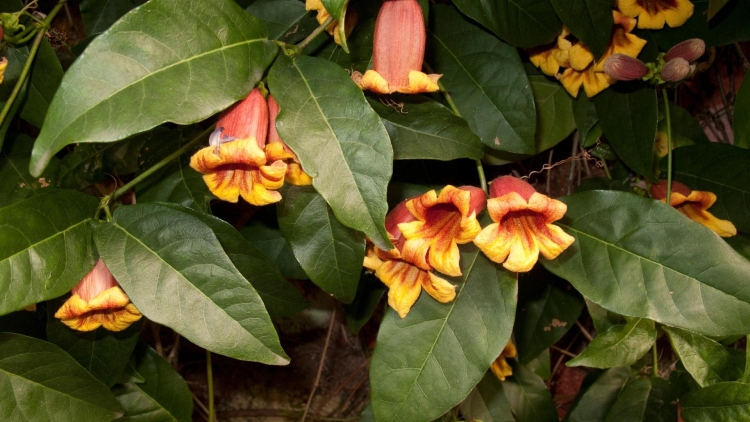
Easily grown in average, medium, well-drained soil in full sun to part shade. Tolerates full shade, but best flower production occurs in sun.
Prune after flowering if needed.
Above ground stems are not reliably winter hardy throughout USDA Zone 5 where they may die to the ground in severe winters (roots are usually hardy therein and will sprout new growth the following spring).
In colder areas, it is best to plant this native climber in a protected location and apply a winter mulch. Established plants may send up root suckers which should be removed if spread is not desired.
Cross-vine is a vigorous, semi-evergreen, woody native, which climbs by tendrils. It is grown primarily for its orange-red, trumpet-shaped spring flowers and for its ability to rapidly cover structures with attractive foliage.
In the wild, it typically grows 35-50′ (less frequently to 70′) and is often found climbing up the trunks of tall trees or sprawling along the ground. In cultivation, it usually grows shorter.
Foliage remains evergreen in the South, but turns reddish-purple in fall with subsequent leaf drop in the coldest areas of its range.
Fragrant, trumpet-shaped, orange-red flowers (to 2″ long) appear in spring. Flowers are followed by greenish, pod-like seed capsules (to 7″ long) which mature in late summer and persist into fall. A cross section of stem reveals a marking resembling the Greek cross, hence the common name.
- Common Name: cross vine
- Zone: 5 to 9
- Plant Type: Vining
- Family: Bignoniaceae
- Native Range: Native to Missouri, Arkansas, Oklahoma and Texas plus Southern portion of the northeast and well established into the deep south. Possible to grow in some northern regions, into southern Ontario with winter protection.
- Height: 35 to 50 feet
- Spread: 6 to 9 feet
- Bloom Time: May – June
- Bloom Color: Orange-red
- Sun: Full sun to part shade
- Water: Medium
- Maintenance: Medium
Campsis radicans
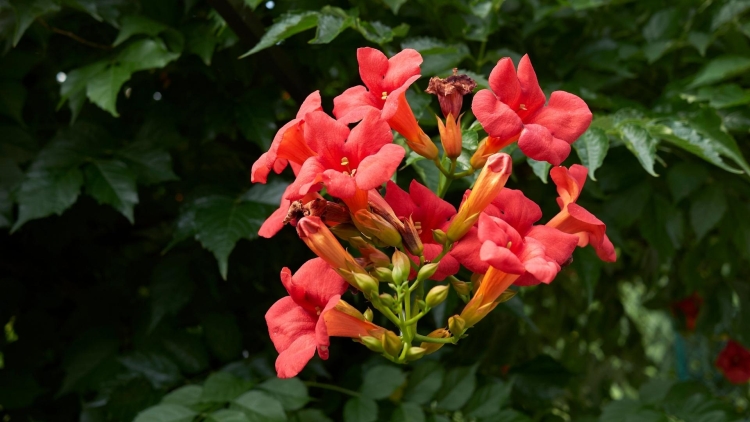
A fast growing native with flowers that attract hummingbirds.
Will naturalize and take over if not kept in check.
The problem with this native climber , is usually not how to grow it but how to restrain it. Trumpet creeper blooms on new growth, so early spring pruning will not affect the flowering.
Must be grown on sturdy structures because mature plants produce considerable weight.
This is an extremely aggressive plant which suckers profusely from underground runners and freely self-seeds. It is not wise to plant near house or other structure where the plant can grow under and rip off siding from your home or garage.
Will form impenetrable colonies in the wild which can choke out many plants that get in its way.
Radicans means stem-rooting in reference to the aerial rootlets.
A good plant for Woodland gardens and naturalized areas. Provides quick cover for fences, arbors, trellises, walls or other structures in the landscape.
Also may be grown along the ground to camouflage rock piles or old tree stumps.
A good climber for hot, dry sites. Needs lots of room. Excellent for hummingbird gardens.
Easily grown in most soils. Best in lean to average soils with regular moisture in full sun. Foliage grows well in shade, but plants need good sun for best flowering.
- Common Name: trumpet creeper
- Zone: 4 to 9
- Plant Type: Vining
- Family: Bignoniaceae
- Native Range: Southeastern United States and beyond as it is naturalized throughout Most of the United States and Canada.
- Height: 25 to 40 feet
- Spread: 5 to 20 feet if running up a pole.
- Bloom Time: July and August
- Bloom Color: Orange, scarlet
- Sun: Full sun to part shade
- Water: Medium
- Maintenance: High
Celastrus scandens
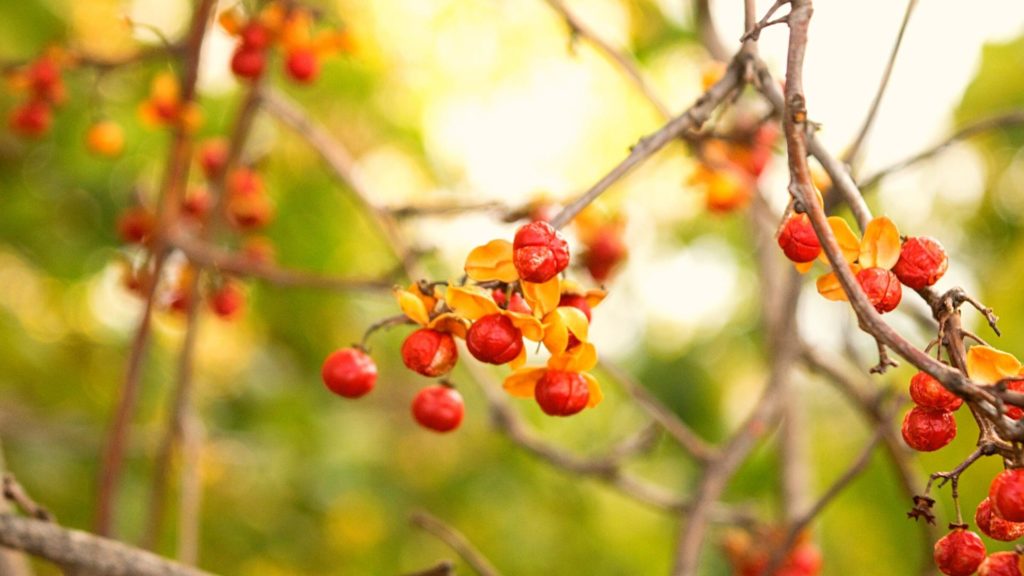
Do not confuse this American gem with the invasive Oriental Bittersweet (C. orbiculatus ).
Bittersweet berries attracts birds and other wildlife and the vines offer protection and nesting.
Fall and winter interest.
Easily grown in most soils.
Best in lean to average soils with regular moisture in full sun. Lean soils help restrain growth. Will grow in part shade, but needs full sun for best flowering and subsequent fruit display.
Prune in late winter to early spring. Mature vines require little pruning other than removal of dead or excess growth.
These native are primarily dioecious (separate male and female plants), (although some have a few perfect flowers and newer cultivars are on the market that eliminate the need for male and female plants.)
Female plants need a male pollinator to produce the attractive fruit that is the signature of this vine.
Unfortunately, some nurseries do not sell the vines as male or female (as is commonly done with hollies). Generally one male plant is needed for 6-9 female plants. Female plants may be vegetatively propagated to create more female plants.
This plant may be grown on structures or allowed to ramble along the ground. It is generally best to avoid growing up small trees or through shrubs because this plant grows rapidly and can girdle trunks and branches causing damage and sometimes death.
American bittersweet is a deciduous twining woody plant that is best known for its showy red berries that brighten up fall and winter landscapes. This species is native to central and eastern North America. It is often seen growing along the ground, over and through low shrubs or circling trees in the wild.
Fruits split open in fall to reveal scarlet fleshy berry-like seeds (arils). Fruits are poisonous if ingested, but are considered to be quite tasty by many birds.
A native plant for woodland gardens, naturalized areas. Provides quick cover for fences, arbors, trellises, posts, walls or other structures in the landscape. Also may be grown along the ground to camouflage rock piles or old tree stumps.
- Common Name: American bittersweet
- Zone: 3 to 8
- Plant Type: Vine
- Family: Celastraceae
- Native Range: North America
- Height: 15 to 20 feet
- Spread: 3 to 6 feet
- Bloom Time: May – June
- Bloom Color: Greenish-white to yellow
- Sun: Full sun
- Water: Medium
- Maintenance: Low
Clematis virginiana
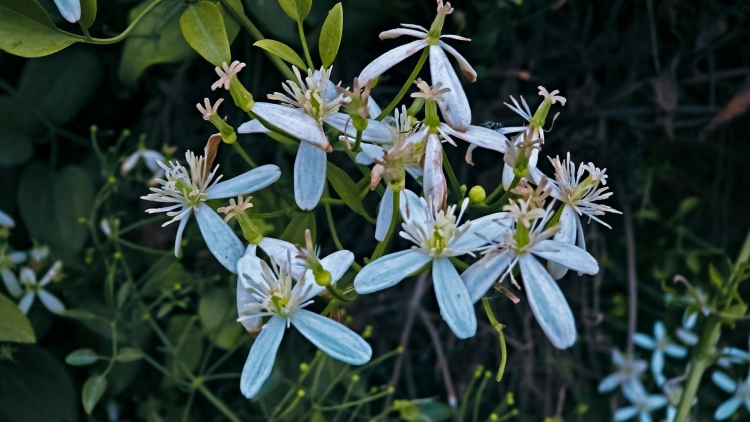
Plant will naturalize. Showy fragrant white flowers in late summer through early fall.
Easily grown in average, medium to wet, well-drained soils in full sun to part shade. This species will thrive and bloom in considerable shade. Blooms on current year’s growth. May be pruned back hard (to 8-12” from the ground) to strong leaf buds in fall after flowering or in late winter to early spring.
A native vine that needs adequate supply of nutrients during the growing season to support rush of growth. Can spread aggressively by self-seeding and suckering.
Woodbine is a fall-blooming native vine that is somewhat similar in flower to the introduced species Sweet autumn clematis (C. terniflora), but lacks the tough, leathery leaves of the latter.
It is native to eastern North America, where it typically occurs in moist low woodland areas and thickets bordering streams, ponds and fence rows.
A vigorous, deciduous, twining native vine with a rampant growth habit. If given support, it will climb rapidly with the aid of tendrilous leaf petioles to 20’. Without support, it will sprawl along the ground as a dense, tangled ground cover. Features sweetly aromatic, 1.25” diameter, pure white flowers (each with 4 narrow petal-like sepals) in axillary panicles from late August to October in a profuse bloom which typically covers the foliage.
This is a dioecious native vine, with the pistillate flowers giving way to attractive, plume-like seed heads (hence the sometimes common name of old man’s beard). Compound green leaves, each with 3-5 oval to elliptic sharply-toothed leaflets.
No serious insect or disease problems. Can be somewhat aggressive spreader.
Perhaps best in woodland and native plant areas where it can be allowed to scramble along the ground, over shrubs and along fences. Also may be grown on trellises, arbors, or posts. If grown through large shrubs, growth should be monitored to insure that the shrub is not overwhelmed.
Other native vine species of Clematis is C. occidentalis or purple clematis, western blue virgin’s-bower.
- Common Name: woodbine
- Zone: 3 to 9
- Plant Type: Vining
- Family: Ranunculaceae
- Native Range: Eastern two-thirds North America, including the Great Plains and Prairies.
- Height: 12 to 20 feet
- Spread: 3 to 6 feet
- Bloom Time: August – October
- Bloom Color: White
- Sun: Full sun to part shade
- Water: Medium to wet
- Maintenance: Low
Clematis ligusticifolia Nutt.
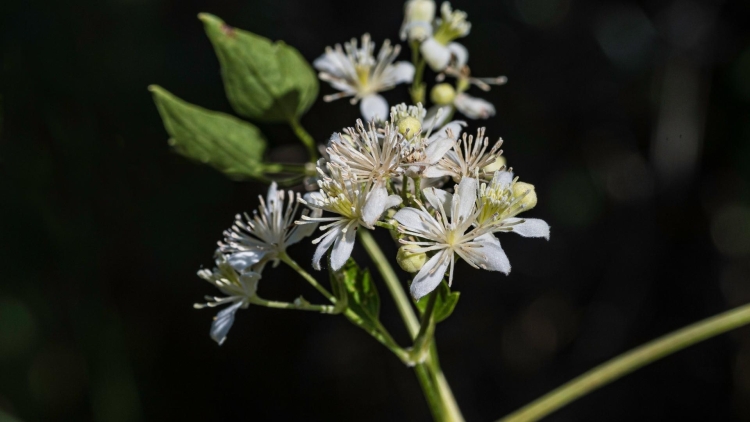
A strong, woody or semi-woody climber to 20 ft. or more. The wide clusters of creamy-white blossoms, from leaf axils on the upper portions of the plant, occur in such profusion they impart a white color to the whole mass of growth.
These are followed by light-catching, silky seed plumes. Deciduous leaves are pinnately compound with 5-7 leaflets.
This species’ traditional name, Pepper Vine, referred to the acrid, peppery taste of the stems and leaves, which Native Americans chewed as a remedy for colds and sore throats.
It is said that the crushed roots were placed in the nostrils of tired horses to revive them.
Caution is advised: The genus is known to have poisonous species.
Small birds and rodents use the canopy for cover and nesting.
Few pest or problems with this native plant.
Ideal for the xeriscape gardening and erosion control.
- Common name: Western white clematis, Virgin’s bower, Pepper vine, Hierba de chivo
- Native Plant: native to Western U. S. ans Canada.
- Zone: 5 to 7
- Plant type: Vining
- Family: Ranunculaceae (Buttercup Family)
- Native Range: From the Prairies and West.
- Bloom Color: White
- Height: to 20 feet.
- Sun: Full sun
- Water: Medium to low
- Maintenance: Low
Lonicera sempervirens
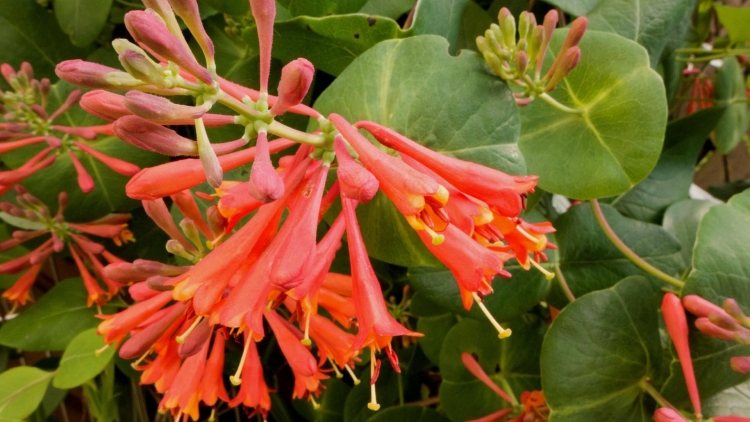
A native plant with attractive flowers attract hummingbirds, butterflies and other pollinators, showy fruits offer food for birds
Easily grown in average, medium, well-drained soil in full sun. Tolerates shade, but the profuseness of flowering is inversely proportional to the amount of shade. Adapts to a wide range of soils. Prefers moist, loamy soils. Blooms primarily on previous year’s stems, so prune to shape after flowering.
Trumpet honeysuckle is a vigorous, deciduous, twining native which typically grows 10-15′ (less frequently to 20′) and is one of the showiest of the native vining honeysuckles. Large, non-fragrant, narrow, trumpet-shaped flowers are scarlet to orangish red on the outside and yellowish inside.
Flowers appear in late spring at stem ends in whorled clusters. Flowers give way to small red berries which mature in fall and are attractive to birds.
Oval, bluish-green leaves on this native plant are glaucous beneath. This native vine is evergreen in the warm winter climates of the deep South, hence the species name of sempervirens (meaning “evergreen” in Latin). Although probably not indigenous to many parts trumpet honeysuckle has escaped cultivation and naturalized in some areas.
No serious insect or disease problems.
Best grown on trellises, fences, arbors or pergolas.
Lonicera dioica (limber or wild honeysuckle) is a more wild form of native vine honeysuckle that is used for larger habitats.
Moderate moisture; woods, forests; in rocky soil.
- Common Name: trumpet honeysuckle
- Zone: 4 to 9
- Plant Type: Vine
- Family: Caprifoliaceae
- Native Range: Eastern and central United States. This native has found favor in gardens of the Great Plains and Prairies of North America
- Height: 10 to 20 feet
- Spread: 3 to 6 feet
- Bloom Time: May – June and intermittently throughout the growing season
- Bloom Color: Scarlet/orange with yellow inside
- Sun: Full sun
- Water: Medium
- Maintenance: Low
Parthenocissus quinquefolia

Fruit attracts birds, foliage has attractive fall color and fall color and the showy fruit lasts into winter.
Easily grown in average, medium, well-drained soil in full sun to part shade.
Tolerates full shade and a wide range of soil and environmental conditions.
This native vine is a deciduous, woody vine that is found in open areas in ravines, rich woods and valleys. A vigorous tendril-climber that needs no support and typically grows 30-50′. Adheres to flat surfaces (e.g., brick, stone or wood walls) via adhesive disks at the tendril ends.
Compound-palmate leaves (usually 5 leaflets, with each leaflet to 6″ long) emerge purplish in spring, mature to dull green in summer and change to purple to crimson-red in autumn.
Fall color can be quite attractive on this native vine. Clusters of small, greenish-white flowers appear in the upper leaf axils in late spring to early summer, but are generally hidden by the foliage. Flowers give way to dark blue to black berries which are attractive to birds. Closely related to and once included in the genus Ampelopsis.
No serious problems. Mildews, leaf spots, canker and wilt are occasional problems. Also susceptible to a number of insect pests including beetles, scale and leaf hoppers.
Once attached to the side of a building or home, it becomes difficult to remove and will damage painted surfaces and leave residues.
A host plant for Silver-spotted Skipper (Epargyreus clarus) butterfly.
- Common Name: Virginia creeper
- Zone: 3 to 9
- Plant Type: Vine
- Family: Vitaceae
- Native Range: Eastern two-thirds United States and Canada into Mexico.
- Height: 30 to 50 feet
- Spread: 5 to 10 feet
- Bloom Time: May – August
- Bloom Color: Greenish white
Passiflora incarnata
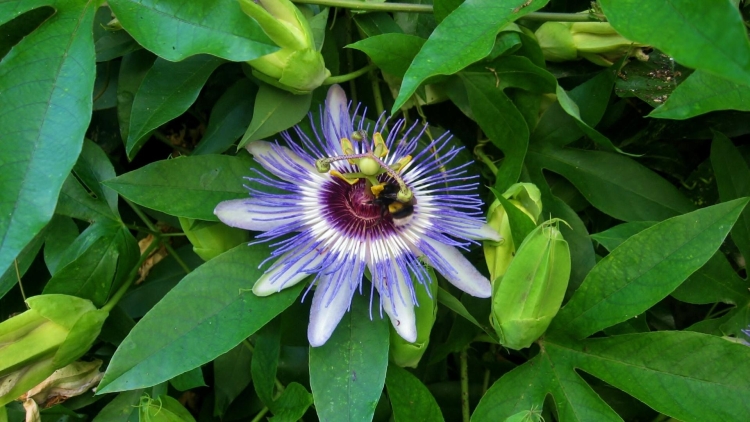
Very attractive flowers attract butterflies. This native vines is a host plant for Passionvine swallowtail butterflies.
Fruits are edible.
Grow in average, medium moisture, well-drained soil in full sun to part shade.
It will tolerant of drought.
Roots appreciate a loose mulch. Although this species is the hardiest of the native vine passion flowers, it is not reliably winter hardy throughout USDA Zone 5 and may not survive extremely cold winters (I have grown this in Michigan with winter protection). It is best to plant in a protected area. Can be easily grown from seed.
Passion flower is a rapid-growing native with tendril-climbing This plant may woody in warm winter climates and herbaceous (dies to the ground) in cold winter climates. A native of the Southeastern U.S. including and up to Indiana and Illinois, where it typically occurs in sandy soils, low moist woods and open areas.
Features three-lobed, dark green leaves and showy, 2.5″ diameter, fringed flowers having white petals and sepals and a central crown of pinkish-purple filaments.
Flowers bloom in summer and are fragrant. Fleshy, egg-shaped, edible fruits called maypops appear in July and mature to a yellowish color in fall. Ripened maypops can be eaten fresh off or made into jelly. Maypop is also a common name for this vine.
No serious insect or disease problems for this native vine. Roots can spread aggressively.
May be used on trellises, arbors, walls or fences. The unique flower and edible fruit make this vine an extremely interesting plant for the garden.
- Common Name: wild passion flower ‘Maypop’
- Zone: 5 to 9
- Plant Type: Vine
- Family: Passifloraceae
- Native Range: South and South Central United States, growing native in the southern Plains states of Kansas, Oklahoma, Texas and east.
- Height: 6 to 8 feet
- Spread: 3 to 6 feet
- Bloom Time: July – September
- Bloom Color: White with purple crown
- Sun: Full sun to part shade
- Water: Medium
- Maintenance: Medium
Vitis riparia / V. aestivalis (summer grape)
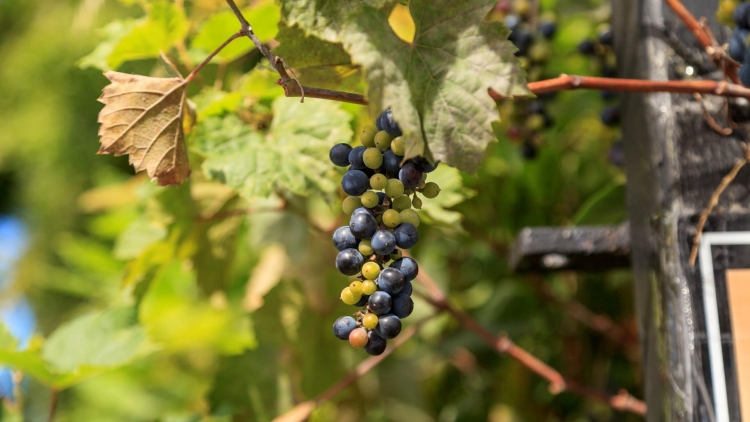
Vitis riparia, also commonly known as River Bank Grape or Frost Grape, is a native vine of America, climbing or trailing vine, widely distributed from Quebec to Texas, and Montana to New England.
It is long-lived and capable of reaching into the upper canopy of the tallest trees. It produces dark fruit that are appealing to both birds and people, and has been used extensively in commercial viticulture as grafted rootstock and in hybrid grape breeding programs.
Mature native vines have loose, fissured bark, and may attain several inches in diameter. Leaves are alternate, often with opposite tendrils or inflorescences, coarsely toothed, 5–25 cm (2–10in) long and 5–20 cm (2–8in) broad, sometimes with sparse hairs on the underside of veins.
The inflorescence is paniculate 4–15 cm (1.5–6 in) long and loose, and the flowers are small, fragrant, dioecious, and white or greenish in color. Wild grapes blooms in May or June and produces a small 6–15 mm blue-black berry (grape) with a bloom, seeded, juicy, edible, vinous in flavor, lacking the “foxy” characteristics of Vitis labrusca, but usually quite sour and herbaceous.
This plant has a wide range and may deviate considerably in detail from the above general description. White berries, perfect flowers, large clusters, large berries, and sweet fruit are among the known variations. However, some observers consider such variations as evidence of natural hybridization with other species of grapes.
V. riparia has the largest geographical range of any of the North American Vitis species. It is present across nearly the entire eastern half of North America, excepting the far south and the most western portions of the great plains. Variants of the species have been observed as far north as Riding Mountain National Park in Manitoba, Canada and as far west as Montana, Nebraska, and North Dakota.
In the wild, the vine thrives along exposed areas with good sun exposure and adequate soil moisture, such as riverbanks, forest clearings, fence lines and along road sides. The species has adapted to a variety of soil chemistries.
If you don’t have the time to maintain wild grapes, they are best left in nature, large habitats, hedges and fence rows.
Smilax spp
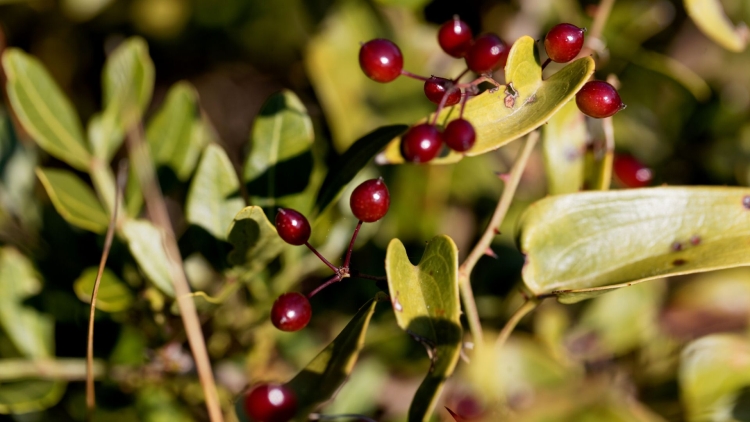
Several species of Greenbrier are native to the Prairies and Great Plains.
Though not a particularly attractive plant, Greenbriers offer food and protection for several species of birds and animals.
Woody or Herbaceous and many are endangered species. These natives need male and female flowers to pollinate.
There are 20 native species in North America north of Mexico. They are climbing flowering plants, many of which are woody and/or thorny. Common names include catbriers, greenbriers, prickly-ivys and smilaxes. Occasionally, the non-woody species such as the Smooth Herbaceous Greenbrier (S. herbacea) is called “carrion flowers” for the unpleasing oder they emit.
The different species of Grenbriers play an important roll in nature, as all of them offer food for pollinators, fruits and berries for birds, small mammals and even larger creatures that forage on fruits.
The thick growing plants also offer protection and nesting sights for many species of birds in your habitats.
- Common name of Greenbrier.
Menispermum canadense L.
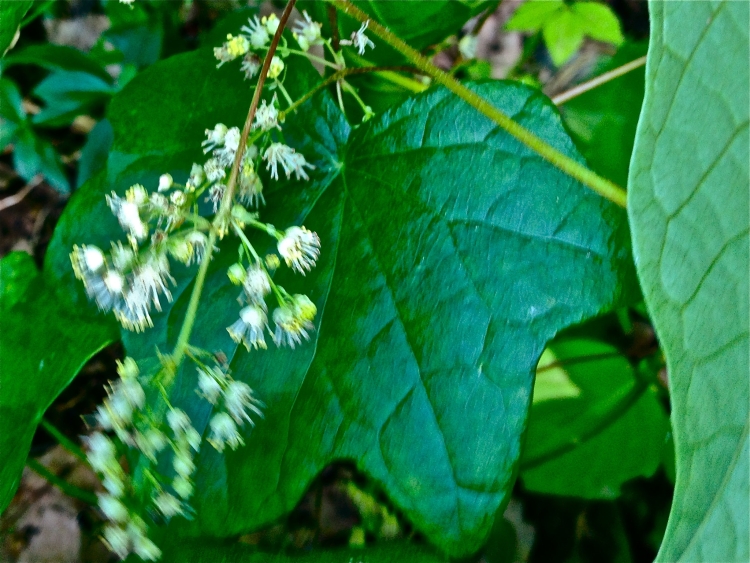
Menispermum canadense is a woody vine, climbing on adjacent plants or running along the ground if nothing is available to climb on. The leaves are simple, alternate and usually shallowly lobed.
Fruits are blue drupes 6-10 mm diameter with a single large flattened seed suggesting a crescent moon (and thereby providing the common name).
The fruits are reported to be poisonous with potentially fatal consequences. The fruits are roughly similar to those of our Vitis riparia (frost grape) and wild food foragers should be very careful to distinguish between the two, and to refrain from eating wild fruits if they are not absolutely sure of the identification.
Because of this, it is not a highly recommended plant for gardens where kids live near.
It is hardy to zone 5. It is in flower from June to July, and the seeds ripen from October to November. The flowers are dioecious (individual flowers are either male or female, but only one sex is to be found on any one plant so both male and female plants must be grown if seed is required)The plant is not self-fertile.
The plant prefers light (sandy), medium (loamy) and heavy (clay) soils. The plant prefers acid, neutral and basic (alkaline) soils. It can grow in semi-shade (light woodland) or no shade. It requires moist soil.
Ideal for large areas where birds and small mammals can feed and find refuge.
- Common name: Canadian moonseed
- Family: Menispermaceae
Summary
Vines may not be for you and your gardens, but they play an important roll in nature and it is important that you know what vines are native and what roll they play in your habitats and gardens.
You may want to see what vines other regions may offer or look into a good native plant source in your area.
